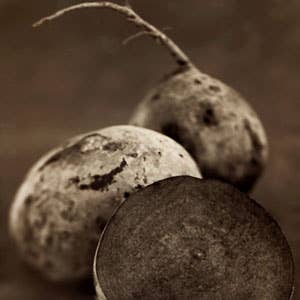
Earthy
Beets are ferocious of hue, boldly sweet, and oddly primordial; they are an intense proposition—a food you either love or hate.
I must've been six or seven when I first faced a beet. Until then, I had happily eaten everything my parents set in front of me: sardines and squid, liver, broccoli. But then came the beet, slices of it slithering from a can. They were mushy and dead-looking, with the sickly-sweet smell of a bog, and I rejected them mentally, emotionally, and physically. My parents, out of compassion, did not press them on me; but from then on my heart would actually hammer at the sight or smell of beets. I'd worry whenever I'd go to eat at friends' houses, for fear their mothers would serve beets or empurple our hard-boiled eggs with beet juice. At restaurants, beets lurked in salads, staining the crisp lettuce and innocent cucumbers with their malevolent, lurid ooze.
Then, several years ago, while in a particularly questing mood that had led me to love, among other things, sea urchin and quinoa, I happened to be at the home of a friend whose cooking I liked and trusted. She had just roasted some fresh beets, and I caught a whiff as they were cooling on the counter. To my surprise, my pulse stayed calm. So I took a bite—and they tasted fresh and heady, the way rich black dirt smells after a rain, with a deep but not cloying sweetness. They were smooth, firm, and slightly crunchy and glistened appealingly in their dish. Fresh beets, I realized, bear no relation to the processed kind, and I have loved them ever since.
The beet, Beta vulgaris, emerged thousands of years ago somewhere along the Mediterranean coasts, and the primordial plant—a leafy green with a puny white or yellowish root—now grows wild on beaches from Europe to India to Australia. Over the centuries, it begat swiss chard, also known as leaf beet; the mangold or mangel-wurzel, a foot-long beet grown for livestock feed; the white sugar beet, which yields 40 percent of the world's refined sugar (and nearly half the refined sugar in the United States); and, of course, the table beet, for which we should thank the early Romans, who were probably the first to develop the root—including its red varieties—for food.
Beets are still sold, at least in this country, mostly in cans or jars (twice as many beets are grown for processing as for selling fresh). But fresh beets are far more flavorful and versatile: they can be sliced raw into crunchy, paper-thin wafers and tossed with a mustardy vinaigrette; roasted or boiled or sauteed until tender; even pickled, with horseradish and onion. In India, beets are simmered with spices like turmeric and black mustard seed. The Germans make a red sauerkraut with beets, bacon, and green cabbage; and the Lebanese like to slather steamed beets with a thick, garlicky yogurt sauce sprinkled with mint. In eastern Europe, where the beet is venerated, tables teem with beet dishes—such as Russia's vinegret, a salad of beets, potatoes, carrots, brined cucumbers, and raw onion; c´wikl-a z chrzanem, the horseradish-beet condiment of Poland; and, of course, beet soup, eaten all across the region in countless guises, from the sturdy Ukrainian borscht to a clear, brilliant Polish version in which mushroom dumplings bob.
Gold beets are okay, and chioggias—spiraled red and white inside like lollipops—are charming, but to me the plain round red beet is the fascinating one. Part of the pleasure lies in the cooking of it. While it's still warm, you can slip its skin off easily with your fingers, and there in your hand—sticky and sanguine with juice—is a glossy, heavy globe that looks like a gigantic ruby. Its glorious purplishness comes from betacyanin, a substance that also tints bougainvillea and perhaps, in times past, human cheeks (it's said that Russian women once used beet juice as rouge). And no other vegetable is so alluringly earthy. What makes it taste that way are infinitesimal amounts of a compound called geosmin, also found in farm-raised catfish and blue-green algae. Microoganisms in soil produce this compound, and for some reason the beet absorbs more geosmin than does any other root vegetable—so it truly is the earthiest of them all.
I suppose I could be sad about my years of missing out on beets. But why? To discover that something I once considered so loathsome can inspire in me such unmixed delight—well, that is yet one more small proof that life is worth living.
Keep Reading
Continue to Next Story










